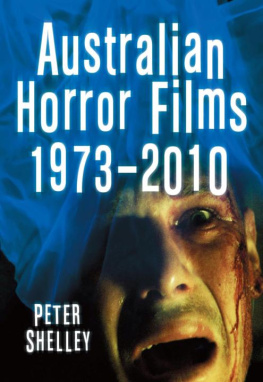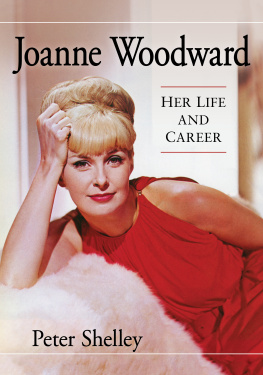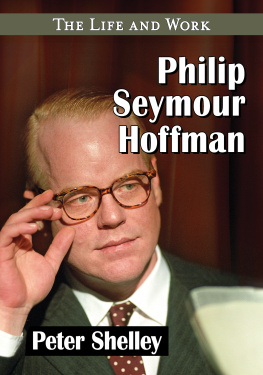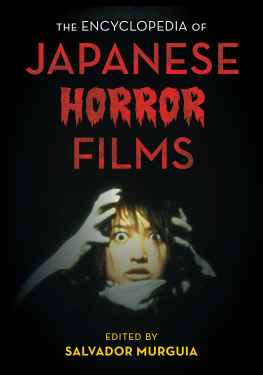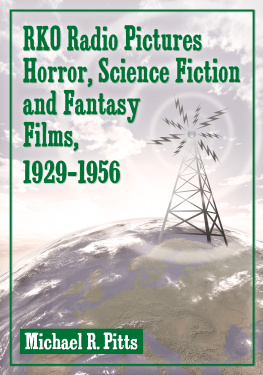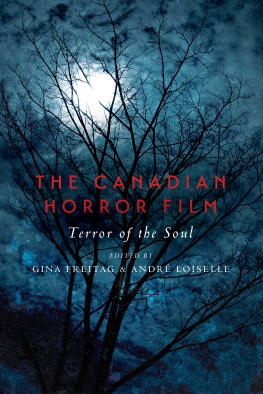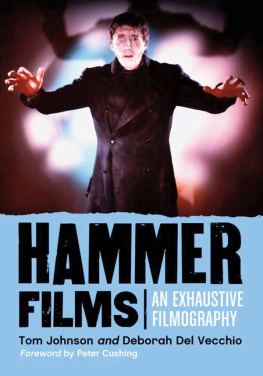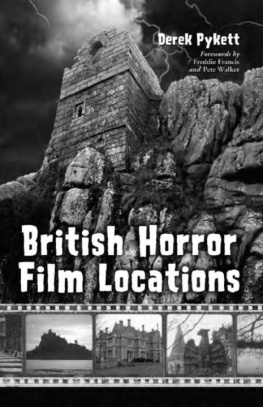Frances Farmer: The Life and Films ofa Troubled Star (2011)
Jules Dassin: The Life and Films (2011)
Grande Dame Guignol Cinema: A History of Hag Horror from Baby Jane to Mother (2009)
PETER SHELLEY




As with my first three books, I thank Barry Lowe for his financial contribution and invaluable assistance. Additional thanks goes to Kath Perry for her financial contribution and moral support, and to Kate Avery, Bigpond Movies DVD, Alex Broun, Allyson Browne, Peter Dickson, Boze Hadleigh, Chris Lewis, Cheryl Loveridge, Annemarie Lloyd, Anne-Louise Luccarini, Kerry McDermott, Lisa Peers, Anita Plateris, Wendy Salvation, Stewart South, and Andrew Traucki.
My interest in horror movies as guilty pleasures resulted in my first book, Grande Dame Guignol Cinema. I subsequently wanted to find another subgenre of horror to write about. This book, then, has been written as the first literary study of Australian horror films to date to describe what is unique about them and their thematic concerns, and highlight films that may be known to horror cinephiles but neglected by the general public.
For the purposes of my study I have defined a horror title with specific criteria. By my definition a horror film features either the theme of the horror of personality, which can be demonstrated by an aggressive human or an animal behaving in a natural manner, or the malevolent supernatural being which can be also extended to an animal that has been mutated and hence behaves in an non-naturalistic manner.
Additionally, the violence expressed is employed as intentional murder rather than accidental death and the death lacking any ambiguity, e.g., when the exact reason for the death is unknown or unseen. Some may find fault with the criteria, but I chose it to differentiate the films I wanted to write about from others that may be more accurately described as examples of the mystery, science fiction or thriller format, although those I have selected may also feature elements from these related genres.
I viewed some titles that are considered by others to be horror movies: Picnic at Hanging Rock (1975), Dead-End Drive-In (1986), Dangerous Game (1987), Frenchman's Farm (1987), Howling III.- The Marsupial (1987) where the half-human half-wolf creatures only attack in self-defense, The Tale ofRuby Rose (1987), Dead Sleep (1990), BeDevil (1993), In the Winter Dark (1998), Reign in Darkness (2002), Visitors (2003), Sleep-Paralysis (2004), Gabriel (2007), Gone (2007), Lake Mungo (2008), The Dinner Party (2009), and Van Diemen's Land (2009), which
presents cannibalism out of survival necessity. However, since they lack either of the criteria, I have not included them in my coverage. I have also omitted various titles that may feature the relevant themes, but as pieces of filmmaking have no redeeming artistic merit.
Some of the titles I have chosen have foreign cast and crew but have been included as Australian horror titles since they were filmed or partly filmed on Australian locations. These include Komodo, Ghost Ship, Queen ofthe Damned, Darkness Falls, Man-Thing, See No Evil, Voodoo Lagoon, and The Ruins. Others have been made by Australian producers but not on location in Australia: Dead Kids (1981), Demonstone (1989), The Mangler (1995), Greg Arce's Den (2001), Saw (2004), and have therefore not been included.
I have also excluded titles that have yet to receive a DVD release at the time of writing and that may have fit my criteria. These include Bad Behaviour (2010), Carmella Hyde (2010) 10 Days to Die (2010), Uninhabited (2010), Come and Get Me (2011), Snowtown (2011) and Relentless (2011).
I have viewed all of the titles to accurately describe their content and to give my critical evaluation and assessment. I make observations on the films in terms of narrative, filmmaking technique and style, and performance. I also point out the themes that are featured and how the narrative and treatment deal with the conventions of horror movies. Mention is made of any recurring motifs, including the foreigner in a strange land as an extension of international casting, the stereotype of the rural ocker, the female warrior, the presence of Aboriginal issues, and the notion of female nudity being considered as sexist exploitation.
I do not have the agenda of a slavish, biased fan, so I do not hesitate to point out elements that are disappointing or downright bad, or praise things I think are good. I present my aesthetic bias by defining the use of certain filmmaking techniques as "postmodern." These techniques include expressionist camera angles and handheld camerawork, fast and slow motion, jump cuts and rapid editing, blackouts and whiteouts, CGI and optical effects, subjective camera and point of view.
Although I acknowledge that some of these techniques have been used in earlier films, I draw attention to them when necessary since many contemporary directors seem to rely too heavily on them for my taste.
For each film I have created a chapter with titles listed in chronological order of the year of their release, and in alphabetical order for the titles released in the same year. Each chapter has a cast and crew filmography taken from the film, supplemented by information on the Internet Movie Database to include uncredited cast and crew members. The title's name has been taken directly from the viewed film so that, for example, Lady Stay Dead is Lady, Stay Dead, and Cthulhu is H.P. Lovecraft's Cthulhu.
As many of the titles are not available commercially, I have accessed prints from auctions and collectors, and therefore not judged the quality of photography too harshly in these sometimes less than ideal copies. Additionally,
some errors may have been made in the spellings of credits and cast listings owing to the poor quality copies of the films viewed, for which I apologize, although some filmmakers seem to deliberately obscure cast names in opening credits in their misguided view that the footage under the credits is more important.
In my chapter notes I also give the history of the producers and main actors and provide any known behind-the-scenes information including that disclosed in DVD audio commentaries and "making of" featurettes. I have also provided an introduction chapter with a brief history ofAustralian film for context and make mention of the few potential horror titles that were released prior to 1973.
I hope this study encourages readers to seek out and watch the films I am enthusiastic about, or even seek out and watch the ones I am less than enthusiastic about but which have redeeming aspects. Some believe that a horror film is successful if it can provide the jolts of shock and surprise that are the subgenre's base appeal. However, it is encouraging to see how satisfying some titles are when the filmmakers attempt more, while still contending with the narrative contrivances, silliness, graphic violence and black humor that are aligned with horror material.

